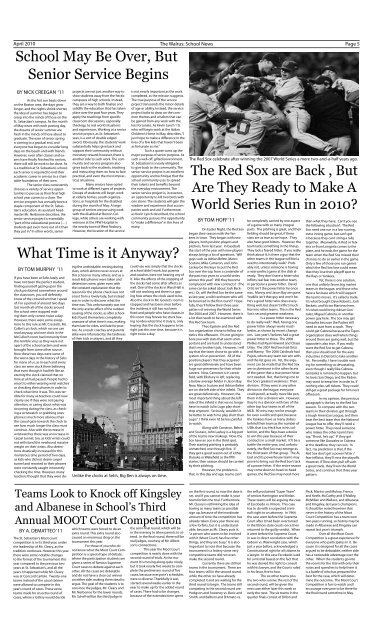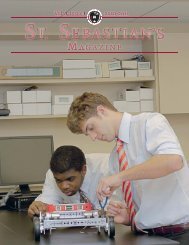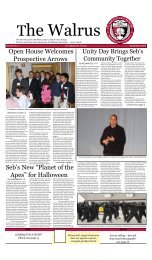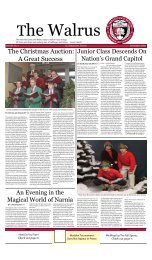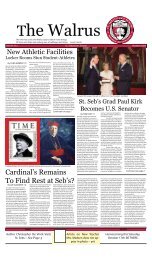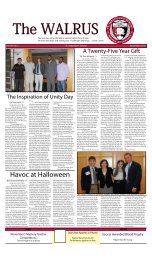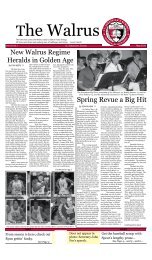enjoyed
April 2010 - St. Sebastian's School
April 2010 - St. Sebastian's School
- No tags were found...
You also want an ePaper? Increase the reach of your titles
YUMPU automatically turns print PDFs into web optimized ePapers that Google loves.
April 2010 The Walrus: School News<br />
Page 5<br />
School May Be Over, But<br />
Senior Service Begins<br />
BY NICK CREEGAN ‘11<br />
As the hot sun beats down<br />
on the Boston area, the days grow<br />
longer, and the nights shrink shorter,<br />
the idea of summer has begun to<br />
creep into the minds of those on the<br />
St. Sebastian’s campus. As the month<br />
of May nears with each passing day,<br />
the dreams of senior summer are<br />
fresh in the minds of those about to<br />
graduate. The ease of senior spring<br />
is coming to a gradual end, and<br />
everyone has begun to consider long<br />
days on the beach and with friends.<br />
However, even after classes and exams<br />
have finally finished for seniors,<br />
there will still be work to be done. As<br />
is a tradition at St. Sebastian’s school,<br />
each senior is required to end their<br />
academic career in service to a charitable<br />
foundation of their own.<br />
The senior class consistently<br />
chooses a variety of service opportunities<br />
to pursue as their final high<br />
school year comes to a close. The<br />
service program has annually been a<br />
staple component of the St. Sebastian’s<br />
education. As assistant headmaster<br />
Mr. Nerbonne describes, the<br />
senior service project is essentially<br />
“part of the educational process […]<br />
students get even more out of it than<br />
they put in.” In other words, senior<br />
projects are not just another way to<br />
shoo students away from the hectic<br />
campuses of high schools. Instead,<br />
they are a way to both finalize and<br />
solidify the education that has taken<br />
place over the past four years. They<br />
apply the teachings from specific<br />
classroom discussions, especially<br />
theology, to real world situations<br />
and experiences. Working at a senior<br />
service project, as St. Sebastian’s<br />
sees, is a sort of double edged<br />
sword. Obviously, the students’ work<br />
substantially helps give back and<br />
support their community without<br />
monetary reward; however, there is<br />
another side to such work. The community<br />
and service program also<br />
gives back to the students, teaching<br />
and instructing them on how to face<br />
practical, and even the most impractical,<br />
situations.<br />
Many seniors have opted<br />
to work at different types of projects.<br />
Groups of students will begin work<br />
at elderly homes, youth organizations,<br />
or hospitals for the disabled<br />
during the month of May. A large<br />
group of seniors are pursuing work<br />
with the disabled at Boston College,<br />
while others are working with<br />
veterans at the VFW Hospital in<br />
the nearby town of West Roxbury.<br />
However, the location of the service<br />
is not nearly important as the work<br />
completed, as the mission suggests.<br />
The true purpose of the service<br />
project transcends the minor details<br />
of age or ability. Instead, the service<br />
project looks to draw on the common<br />
themes and wisdom that can<br />
be gained from any work with the<br />
less fortunate. As Kevin Lynch ’10,<br />
who will begin work at the Italian<br />
Children’s Home in May, describes, “I<br />
just hope to make a difference in the<br />
lives of a few kids that haven’t been<br />
as fortunate as me.”<br />
Such a quote sums up the<br />
major purpose of senior purpose. As<br />
such a well-off, gifted environment,<br />
St. Sebastian’s is nearly obligated<br />
to give back to the community. The<br />
senior service project is an excellent<br />
opportunity and technique that the<br />
school community uses to spread<br />
their talents and benefits beyond<br />
the everyday environment. The<br />
senior service project is, in essence,<br />
an opportunity to kill two birds with<br />
one stone. The students will gain the<br />
wisdom and experience that accompanies<br />
work and aid. Furthermore,<br />
as Kevin Lynch described, the school<br />
community pursues the opportunity<br />
to “make a difference” in the lives of<br />
many.<br />
What Time is it Anyway?<br />
BY TOM MURPHY ‘11<br />
If you have been at Sebs lately and<br />
have not been the perfect student,<br />
finding yourself gazing upon the<br />
clock positioned somewhere around<br />
the classroom, you will definitely<br />
know of the conundrum that I speak<br />
of. For a period of around two days<br />
last month all of the clocks around<br />
the school were stopped making<br />
them only correct twice a day.<br />
However, there were some exceptions<br />
to this rule as Mr. Cressotti, Ms.<br />
Callini’s pi clock, which no one can<br />
read anyway, and one clock in the<br />
McCulloch room had immunity from<br />
this terrible virus as they were not<br />
apart of the school system and were<br />
brought from some other source.<br />
Now these two days were some of<br />
the worst days in the history of Sebs<br />
for many of us, as in each and every<br />
class we were stuck there believing<br />
that even though it had felt like an<br />
eternity the clock claimed that no<br />
time at all had passed. People had to<br />
resort to either wearing wrist watches<br />
or checking their phones in order to<br />
check what time it was. This was terrible<br />
for many as teachers could now<br />
clearly see if they were not paying<br />
attention, or caring about what was<br />
occurring during the class, as checking<br />
a wristwatch or grabbing ones<br />
phone is much more obvious than<br />
the casual gaze towards the clock to<br />
see how much longer the class must<br />
continue. Also with the increase in<br />
wristwatches there was an increase in<br />
carpal tunnel, too, as kids’ wrists could<br />
not withstand the newfound massive<br />
weight on their wrists. Also detentions<br />
drastically increased for this<br />
monstrous time period of two days,<br />
as kids who did not desire carpel<br />
tunnel and resorted to their phones<br />
were constantly caught innocently<br />
checking the time. However, many<br />
teachers thought that they were doing<br />
the unthinkable, texting during<br />
class, which almost never occurs at<br />
this school or many others, and as a<br />
result kids phones were taken and<br />
detentions were, given even with<br />
the constant explanation that the<br />
reason for the phone check was not<br />
a text from a lovely lady, but instead<br />
was in order to discover what the<br />
time was. This unfortunately was not<br />
the only averse effect of the sudden<br />
ceasing of the clocks, as after school<br />
kids found themselves completely<br />
unaware of what time it was, making<br />
them late for rides, and late for practice.<br />
As a result coaches and parents<br />
alike were infuriated by the tardiness<br />
of their kids or players, and all they<br />
could say was simply that the clocks<br />
at school didn’t work, but parents<br />
and coaches were not hearing any of<br />
it. Also the effects of the stopping of<br />
the clocks had some after affects as<br />
well. One of the clocks in Ward Hall is<br />
still not working and there is a gaping<br />
hole where the clock used to be.<br />
Also the clock in Mr. Goulet’s room is<br />
stopped and has been since before<br />
the incident, it still has not been<br />
fixed and people who have classes in<br />
this room may forever be stuck having<br />
no idea what time it truly is, only<br />
hoping that the clock happens to be<br />
right just this one time, because it is<br />
right twice a day.<br />
Unlike the clocks at Seb’s, Big Ben is always on time.<br />
The Red Sox celebrate after winning the 2007 World Series a mere two-and-a-half years ago.<br />
The Red Sox are Back , But<br />
Are They Ready to Make A<br />
World Series Run in 2010?<br />
BY TOM HOFF ‘11<br />
On Easter Night, the Red Sox<br />
began their season with the Yankees<br />
in town. They began with new<br />
players, both position players and<br />
pitchers, from last year. In baseball,<br />
the start of the year with new players<br />
always brings a lot of questions. Will<br />
guys such as Adrian Beltre, Marco<br />
Scutaro, Mike Cameron, and John<br />
Lackey be the keys to put the Red<br />
Sox over the top, from a contender of<br />
the past two years to a world series<br />
winner this year? Will they become<br />
complacent with new contracts? (The<br />
same can be asked about Josh Beckett.)<br />
Or, will the Red Sox be the same<br />
as last year, a wild card team who will<br />
be bounced in the first round? Hopefully,<br />
they’ll follow their three-year<br />
pattern of winning the World Series<br />
like 2004 and 2007. However, there is<br />
a lot that needs to be examined with<br />
this Red Sox team.<br />
Theo Epstein and the Red<br />
Sox organization chose to follow statistics<br />
this offseason. I’m not going to<br />
bore you with stats that seem unimportant<br />
and are hard to understand;<br />
that’s my brother’s job. However, I will<br />
say that the team chose to go with a<br />
system of run prevention. All of the<br />
position players that they acquired<br />
are great defensively and have been<br />
huge run-preventers for their whole<br />
careers. Now, Cameron is in center<br />
field, with Ellsbury in left, replacing<br />
a below-average fielder in Jason Bay.<br />
Now, Marco Scutaro and Adrian Beltre<br />
are on the left side of the infield. They<br />
are great defensively. However, the<br />
most important thing about the left<br />
side of the infield is that we no longer<br />
have to watch Julio Lugo play shortstop<br />
anymore. Seriously, wouldn’t it<br />
be better to watch me play short than<br />
Lugo? I think even I’d be less painful<br />
to watch.<br />
Along with Cameron, Beltre,<br />
and Scutaro, John Lackey is a big part<br />
of the team’s new makeup. Now, the<br />
Sox have an ace in the third spot.<br />
Their starting pitching is probably<br />
unmatched, one through five. If<br />
they get a good season out of either<br />
Daisuke or Wakefield as the fifth<br />
starter, their season should be carried<br />
by their pitching.<br />
However, the problem is<br />
that, in this day and age, teams can’t<br />
be completely carried by one aspect<br />
of a game with so many integral<br />
parts. The pitching is great, and their<br />
fielding should be great, if these<br />
stats are as true as we hope. They<br />
also have good hitters. However, the<br />
team lacks something in the lineup.<br />
They lack a feared hitter. If you really<br />
think about it, is there a guy that the<br />
other teams in the league will feel a<br />
need to intentionally walk? Probably<br />
not, unless someone is having<br />
a near-perfect game at the dish already.<br />
They don’t have a hitter who<br />
inflicts real fear into another team,<br />
in particular a power hitter. David<br />
Ortiz isn’t the power hitter he once<br />
was. Manny and Jason Bay are gone.<br />
Youkilis isn’t that guy and won’t be.<br />
He’s a good hitter who does everything<br />
well, but doesn’t inflict much<br />
fear into other teams. This is the Red<br />
Sox’s second greatest weakness.<br />
Is a power hitter necessary<br />
to do really well? Well, having one<br />
power hitter always works much<br />
better, as shown by recent champions.<br />
Last year’s Yankees had a great<br />
power hitter or three. The 2008<br />
Phillies had Ryan Howard and Chase<br />
Utley. The 2007 Red Sox had Ortiz<br />
and Manny. The 2006 Cardinals had<br />
Pujols, whom any team can win with,<br />
and the list goes on. Yet, the argument<br />
can be made that the Red Sox<br />
are so dominant in the other facets<br />
of the game that a true power hitter<br />
isn’t needed. But, that brings me to<br />
the Sox’s greatest weakness: Their<br />
division. If they were in any other<br />
division in the league, everyone<br />
could pencil, actually more like pen,<br />
them in for a division win. However,<br />
they’re in a division with two of the<br />
other top four teams in all of the<br />
MLB. 90 wins may not be enough<br />
for even a wild card spot, because<br />
the Yankees have as many dollars<br />
behind their team as the number of<br />
USBs that Lou Heck has in his collection,<br />
and the Rays have a desire<br />
to win this year because of their<br />
contracts in a small market. It’ll be a<br />
battle the entire year, and, unfortunately,<br />
the Red Sox may emerge as<br />
the third team of that group. The AL<br />
East and its powerhouse teams may<br />
prove to bring out the Red Sox’s lack<br />
of a power hitter. If the entire season<br />
may come down to head-to-head<br />
games, the Red Sox may need more<br />
than what they have. Can’t you see<br />
the following situation?: The Red<br />
Sox need one run in a low scoring,<br />
extra inning game, but can’t get<br />
it because they can’t string a rally<br />
together. Meanwhile, A-Rod or Teixeira<br />
or Evan Longoria comes to the<br />
plate, and he ends the game for the<br />
team when the Red Sox missed their<br />
chances to do so earlier in the game.<br />
Only a few of those one run games<br />
which the Red Sox lose could mean<br />
that they lose their playoff spot to<br />
the Rays or Yankees.<br />
Yet, there is one solution,<br />
one that unfairly favors big market<br />
teams in the league, and those who<br />
have a fan base which will support<br />
the team’s moves. It’s called a trade.<br />
It’s what brought Dave Roberts, Josh<br />
Beckett, and Victor Martinez here.<br />
It’s what could bring Adrian Gonzalez,<br />
Miguel Cabrera, or another<br />
power guy here. The Sox may get<br />
Gonzalez because the Padres still<br />
need to start from scratch. They<br />
could get Cabrera because the Tigers<br />
organization does well when things<br />
around them are going well, but the<br />
opposite is also true. If you really<br />
want the Red Sox to get Cabrera,<br />
then you should root for the auto<br />
industries in Detroit to take another<br />
hit. Personally, I have trouble rooting<br />
for something so devastating,<br />
even though I really like Cabrera.<br />
Gonzalez is rumored to happen, but<br />
he loves San Diego, and the Padres<br />
may want to keep him in order to, if<br />
nothing else, sell tickets. They could<br />
still get a great package for him next<br />
offseason.<br />
In my opinion, the previous<br />
paragraph is the key to the Red Sox<br />
season. To compete with the two<br />
teams in their division, get through<br />
a tough American League, and then<br />
beat the best team that the National<br />
League has to offer, they’ll need a<br />
power hitter. They need someone<br />
who makes the other team’s fans<br />
say, “Shoot, he’s up.” IF they get<br />
someone like Gonzalez or Cabrera<br />
at the deadline, they can win. In<br />
fact, my prediction is that, if the<br />
Red Sox don’t get a power hitter /<br />
fear-inflictor, they’ll miss the playoffs.<br />
However, if Theo does pull off such<br />
a great trade, they’ll win the World<br />
Series, and continue that three year<br />
pattern.<br />
Teams Look to Knock off Kingsley<br />
and Albanese in School’s Third<br />
Annual MOOT Court Competition<br />
BY A. DEMATTEO ‘11<br />
The St. Sebastian's Moot court<br />
competition is in its third year, under<br />
the leadership of Mr. Cleary, as the<br />
tradition continues. However this year<br />
there were some notable changes<br />
to the format of the tournament this<br />
year compared to the previous two<br />
years at St. Sebastian's, and all the<br />
years it happened while Mr. Cleary<br />
was at Concord Carlisle. Twenty-one<br />
teams instead of the usual sixteen<br />
were allowed to compete in this<br />
year's round of cases. These extra<br />
teams made for an extra round of<br />
cases, where a lottery would decide<br />
which teams were forced to do an<br />
extra round. This extra round also<br />
caused an enormous drag on the<br />
tournament this year.<br />
For those of you who do<br />
not know what the Moot Court Competition<br />
is a special type of debate,<br />
where the participation students are<br />
given a series of famous Supreme<br />
Court cases to debate against each<br />
other. All the cases are debatable<br />
and do not have a clear cut winner<br />
on either side, making them ideal to<br />
argue. The goal of the students is to<br />
convince the judges, Mr. Cleary and<br />
Mr. Nerbonne for the lower rounds.<br />
Mr. Schell will be the third judge in<br />
the semi-final round, which will be<br />
in the evening to allow parents to attend.<br />
In the final round, there will be<br />
real judges, courtesy of Mr. Albertson's<br />
connections.<br />
This year the Moot Court<br />
competition is nearly done with the<br />
second round of trials. At the moment<br />
it is moving along quite nicely,<br />
but it took nearly five weeks to complete<br />
the preliminary round of five<br />
cases, because everyone's schedules<br />
were so diverse. Thankfully it was<br />
started several weeks earlier in the<br />
year to make up for the added round<br />
of cases. There had to be changes,<br />
because of the extended time spent<br />
on the first round, so now the date is<br />
set, and if you cannot make it, your<br />
team forfeits the trial. Furthermore<br />
Mr. Cleary is rethinking the idea of<br />
having as many teams as possible<br />
sign up, because of the inordinate<br />
amount of time the competition has<br />
already taken. Every year there are<br />
a few forfeits, but it is understandable,<br />
because as Mr. Cleary puts it,<br />
"a person who wants to be involved<br />
with it (Moot Court) has five other<br />
things, and they are busy." It is also<br />
important to note that because the<br />
tournament is a lottery some very<br />
competitive teams did not even<br />
make the second round.<br />
Currently there are still ten<br />
teams in the tournament. There are<br />
four teams still in the second round,<br />
while the other six have already<br />
completed it and are waiting for the<br />
third round to begin. The teams still<br />
competing in the second round are:<br />
Hodgson and Sweeney vs. Bacic and<br />
Smith, and Balboni and D’Amato vs.<br />
the self proclaimed “Super Team”<br />
of seniors Harrington and Kinlan.<br />
These teams will be arguing the case<br />
of Escobedo vs. Illinois. This case<br />
has to do with a suspected criminal’s<br />
right to an attorney. In 1964,<br />
the case went before the Supreme<br />
Court after it had been overturned<br />
in the Illinois state courts once then<br />
returned to the guilty verdict. When<br />
it went before the Supreme Court,<br />
in was in direct correlation with the<br />
Gideon vs. Wainwright case, which<br />
just a year before, acknowledged a<br />
Constitutional right for all citizens to<br />
a lawyer. In this case Escobedo sued<br />
for a mistrial based on the fact that<br />
he was denied the right to consult<br />
with his lawyer, and the Courts ruled<br />
in his favor, five to four.<br />
The six other teams plus<br />
the two who survive the rest of the<br />
second round, will be given the<br />
next case either later this week or<br />
early the next. The six teams in the<br />
quarter finals consist of Dillon and<br />
Peck, Marino and Mulroy, Franco<br />
and Keefe, McCarthy and O’Malley,<br />
McMillan and Wallace, and Albanese<br />
and Kingsley, last year’s champions.<br />
It should be noted however that<br />
never in the history of the Moot<br />
Court Competition has a team won<br />
two years running, so history may be<br />
made in Albanese and Kingsley can<br />
repeat last year’s triumph.<br />
Over all the Moot Court<br />
Competition is a great experience for<br />
everyone who participates in it. Because<br />
it is designed for all the cases<br />
argued to be debatable, neither side<br />
has a noticeable advantage over the<br />
other. When the students go into<br />
the rooms for the trial with only their<br />
notes and speeches to help them it<br />
is a battle of who has prepared the<br />
best for the case, which will determine<br />
the outcome. The Moot Court<br />
Competition is fun to watch and I<br />
encourage everyone to be there for<br />
the final round sometime in May.


